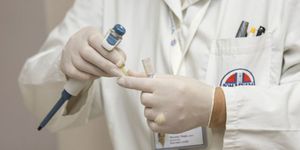Simulating weaker electrical pulses for atrial fibrillation treatment
Currently, an estimated five percent of the U.S. population is living with heart arrhythmia conditions, or conditions that cause irregular heartbeats. These conditions include atrial and ventricular fibrillation. If left untreated, these irregular heartbeat conditions can lead to a number of complications, including the formation of blood clots, strokes, and even heart failure.
A number of options are available to treat conditions like atrial and ventricular fibrillation, such as medications that can help restore a normal heart function, though they do not treat the underlying cause. More aggressive treatments include the use of defibrillating shocks to help jolt the heart back into normal rhythm. Unfortunately, defibrillating shocks can be painful and even cause further heart damage that can lead to new health complications.
To overcome some fo the limitations associated with current fibrillation treatments, researchers at the Max Planck Institute for Dynamics and Self Organization, German Center for Cardiovascular Research, Georg-August-Universitӓt Gӧttingen, and University Medical Center Gӧttingen, are using simulations to examine how to better treat people with atrial and ventricular fibrillation with the use of electrical pulses. Their work is described in a recent article published in Chaos: An Interdisciplinary Journal of Nonlinear Science.
Researchers were particularly interested in simulating responses to what’s called “adaptive deceleration pacing,” a theory that could offer a better approach to treating atrial and ventricular fibrillation that existing defibrillating shocks. Adaptive deceleration pacing involves the use of less powerful bursts of electricity that are spaced out over time. The idea is that these timed pulses could respond more accurately to the hearts beat and account for the impact of previous pulses on changes in the heart’s rhythm. The lower energy of the bursts could also reduce the risks of pain and damage to the heart.
To test this theory, researchers developed a numerical simulation (essentially, a computer program powered by a mathematical model) to understand how this theory might actually work. They tested different pulse sequences to gauge the most effective timing of pulses. They found that adaptive deceleration pacing did in fact improve the frequency of successful attempts to stop an arrhythmia, highlighting a potential path forward in treating this condition.
Sources: Science Daily; Chaos; National Library of Medicine

![Master Lab Weighing: Accuracy, Compliance & Audits [eBook]](https://d3bkbkx82g74b8.cloudfront.net/eyJidWNrZXQiOiJsYWJyb290cy1pbWFnZXMiLCJrZXkiOiJjb250ZW50X2FydGljbGVfcHJvZmlsZV9pbWFnZV85MWRmZmRjMDIwNDBlMWJjMzYwN2ZiYWY2ZjI4ZGMzYzBmZGMwZGMyXzkxOTcucG5nIiwiZWRpdHMiOnsidG9Gb3JtYXQiOiJqcGciLCJyZXNpemUiOnsid2lkdGgiOjcwMCwiaGVpZ2h0IjozNTAsImZpdCI6ImNvdmVyIiwicG9zaXRpb24iOiJjZW50ZXIiLCJiYWNrZ3JvdW5kIjoiI2ZmZiJ9LCJmbGF0dGVuIjp7ImJhY2tncm91bmQiOiIjZmZmIn19fQ==)






